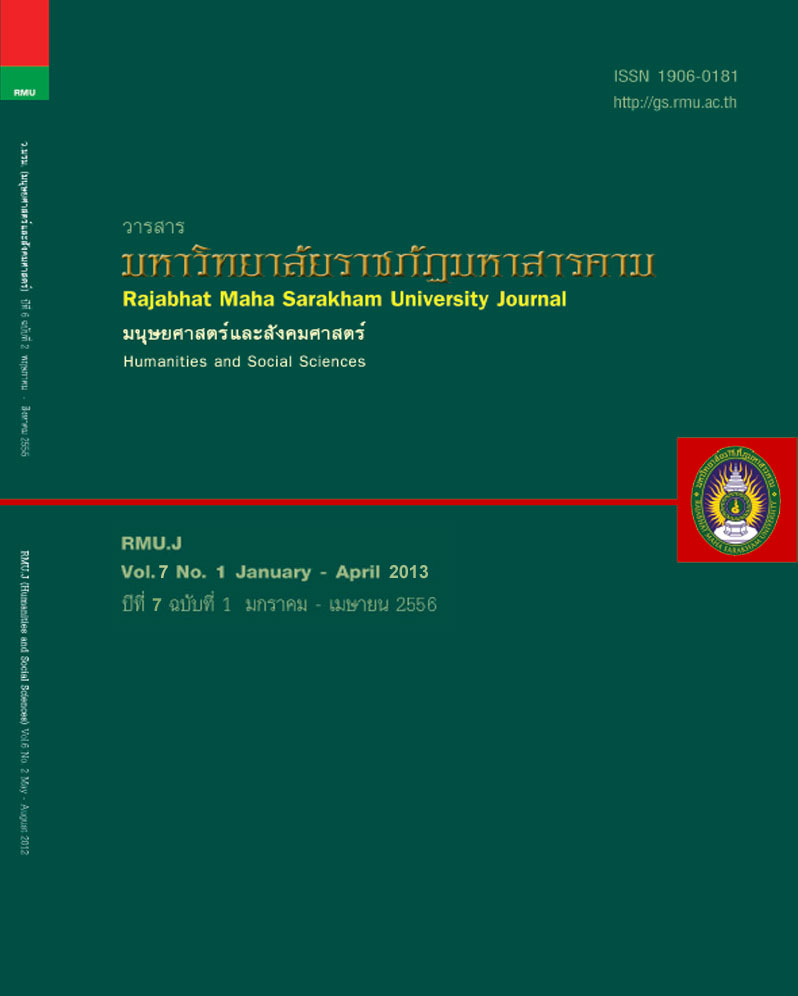การจัดทำแผนชุมชนแบบมีส่วนร่วมเพื่อส่งเสริมเศรษฐกิจพอเพียง ตำบลชัยฤทธิ์ อำเภอไชโย จังหวัดอ่างทอง
Main Article Content
บทคัดย่อ
บทคัดย่อ
การวิจัยครั้งนี้มีวัตถุประสงค์เพื่อจัดทำแผนชุมชนแบบมีส่วนร่วมในการส่งเสริมเศรษฐกิจพอเพียง ตำบลชัยฤทธิ์ อำเภอไชโย จังหวัดอ่างทอง โดยใช้ระเบียบวิธีการวิจัยทั้งเชิงปริมาณและคุณภาพ การศึกษาแบ่งเป็น 3 ขั้นตอน คือ ขั้นที่หนึ่ง ศึกษาสภาพและ ปัญหาการจัดทำแผนชุมชน เพื่อส่งเสริมเศรษฐกิจพอเพียง ขั้นที่สอง ศึกษาปัจจัยที่สนับสนุนให้ชุมชนมีส่วนร่วมในการจัดทำแผน ชุมชน และ ขั้นที่สาม พัฒนารูปแบบการจัดทำแผนชุมชนแบบมีส่วนร่วม
ผลการศึกษาพบว่า ตำบลชัยฤทธิ์ อำเภอไชโย จังหวัดอ่างทอง การจัดทำแผนชุมชนเป็นไปตามขั้นตอนแนวทางของกระทรวง มหาดไทย สิ่งที่ควรปรับปรุงเพิ่มเติม ได้แก่ การจัดเวทีการเรียนรู้ การสื่อสารประชาสัมพันธ์ การร่วมเวทีถ่ายทอดความรู้ของผู้ทรง คุณวุฒิ กลุ่มอาชีพ ปราชญ์ชาวบ้าน การวิเคราะห์ SWOT การค้นหาอัตลักษณ์และการปรับปรุงแผนชุมชนระดับการมีส่วนร่วมมาก คือ การมีส่วนร่วมในการตัดสินใจและการมีส่วนร่วมในการปฏิบัติ การมีส่วนร่วมระดับปานกลางคือ การมีส่วนร่วมในผลประโยชน์ และการมีส่วนร่วมในการติดตามประเมินผล
ปัญหาในการจัดทำแผนชุมชน ประกอบด้วย การขาดการจัดทำแผนชุมชนเชิงคุณภาพ การขาดความรู้ความเข้าใจของผู้เกี่ยวข้อง ผู้นำท้องถิ่นบางส่วนขาดวิสัยทัศน์ ขาดการมีส่วนร่วมของทุกฝ่าย ขาดการสื่อสารประชาสัมพันธ์ที่ดี การวางแผนยังให้ความสำคัญ ด้านวัตถุและโครงสร้างพื้นฐาน ปัจจัยที่ส่งเสริมการมีส่วนร่วมของชุมชนในการจัดทำแผนได้แก่ ผู้นำท้องถิ่น แกนนำชุมชน ปัญหา ความต้องการของชุมชน การเรียนรู้ร่วมกัน การสื่อสารประชาสัมพันธ์ และเครือข่ายองค์กรชุมชน การพัฒนารูปแบบการจัดทำแผน ชุมชน 8 ขั้นตอน ได้แก่ 1) ขั้นเตรียมทีมงาน 2) ขั้นจัดเวทีการเรียนรู้ 3) ขั้นสำรวจและรวบรวมข้อมูล 4) ขั้นวิเคราะห์ข้อมูล 5) ขั้น ยกร่างแผนชุมชน 6) ขั้นประชาพิจารณ์แผนชุมชน 7) ขั้นเสนอแผนชุมชนให้ อบต. และหน่วยงานที่เกี่ยวข้อง 8) ขั้นนำแผนชุมชนไป ปฏิบัติและติดตามประเมินผล
คำสำคัญ : การวางแผนชุมชนแบบมีส่วนร่วม, เศรษฐกิจพอเพียง, การพัฒนาชุมชน
ABSTRACT
The purposes of this research were to study participatory community planning to support the sufficiency economy, and to develop a model of participatory community planning in Tambon Chairit, Chaiyo District, Angthong Province by using both quantitative and qualitative research methodologies.
The study was divided into 3 phases as follows: 1) studying conditions and problems of community planning to support the sufficiency economy, 2) studying factors supporting communities to participate in planning, and 3) developing a model of participatory community planning.
Findings of the study revealed that community planning of Tambon Chairit, Chaiyo district, Angthong was in line with the regulations of Interior Ministry. There were some aspects that should be improved such as organizing learning forums, public relations, experts ‘participation in knowledge transfer, occupation groups, local experts, SWOT analysis, and seeking identity. The participatory community development found at the high level was participation in decision making and implementation; while participation in benefits, follow-ups and evaluation were found at the moderate level.
Problems in community planning were the following: lack of qualitative community planning, concerned personnel lacking knowledge and understanding, some local leaders lacking visions, lacking participation of all concerned offices, and lacking efficient public relations. Participatory planning also emphasized materials and basic structures. Factors supporting community participation in planning were local leaders, community leaders, problems regarding community needs, learning and sharing, public relations, and community organization networks. Development of the model consisted of the following 8 steps: 1) team work preparation, 2) organizing learning forums, 3) survey and data collection, 4) data analysis, 5) drafting community plan, 6) public hearings, 7) submitting plans to Local Administration Organization and concerned offices, and 8) implementation and evaluation.
Keywords : participatory community planning, sufficiency economy, community development
Article Details
1. บทความที่ลงตีพิมพ์ทุกเรื่องได้รับการตรวจทางวิชาการโดยผู้ประเมินอิสระ ผู้ทรงคุณวุฒิ (Peer Review) สาขาที่เกี่ยวข้อง อย่างน้อย 3 ท่าน ในรูปแบบ Double blind review
2. ข้อคิดเห็นใด ๆ ของบทความที่ลงตีพิมพ์ในวารสารมหาวิทยาลัยราชภัฏมหาสารคาม นี้เป็นของผู้เขียน คณะผู้จัดทำวารสารไม่จำเป็นต้องเห็นด้วย
3. กองบรรณาธิการวารสารมหาวิทยาลัยราชภัฏมหาสารคาม ไม่สงวนสิทธิ์การคัดลอกแต่ให้อ้างอิงแสดงที่มา

